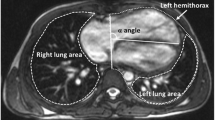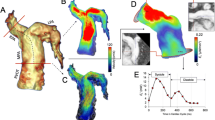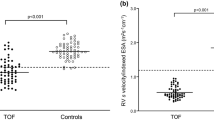Abstract
Significant pulmonary regurgitation (PR) after repair of tetralogy of Fallot (TOF) may affect flow in the pulmonary artery (PA) side branches. We sought to assess flow changes and distensibility of the PA side branches in vivo and test correlation with the degree of PR and right-ventricular (RV) dilatation. Thirty patients after TOF repair and 16 controls underwent cardiovascular magnetic resonance for quantification of RV volumes and measurement of flow in the PA side branches. RV volumes and function, blood flow volumes, and cross-sectional area of the main, left (LPA), and right (RPA) PA were measured and regurgitant volumes and distensibility calculated. Results were compared between the LPA and the RPA and between patients and controls. Median regurgitation fraction of PR was 41 % (range 22–60 %). Regurgitant fraction was greater in the LPA (40 %) than in the RPA (29 %), resulting in lower net flow into the LPA (p < 0.001). LPA area was significantly greater than that of the RPA (303.9 vs. 232.7 mm2/m2) (p < 0.0001). The LPA showed lower distensibility than the RPA (39 vs. 44 %). PA side branch distensibility correlated with MPA regurgitant volume (p = 0.001), MPA regurgitant fraction (p = 0.001), and RV end-diastolic volume (p = 0.03). PA side branches have greater distensibility in patients with PR than in normal subjects. Significant PR leads to changes in flow profile and distensibility of the PA side branches. The LPA shows greater regurgitant volume and greater area but lower distensibility than the RPA.


Similar content being viewed by others
References
Bland JM, Altman DG (1986) Statistical methods for assessing agreement between two methods of clinical measurement. Lancet 1(8476):307–310
Bogren HG, Klipstein RH, Mohiaddin RH, Firmin DN, Underwood SR, Rees RS et al (1989) Pulmonary artery distensibility and blood flow patterns: a magnetic resonance study of normal subjects and of patients with pulmonary arterial hypertension. Am Heart J 118(5 Pt 1):990–999
Buechel ER, Dave HH, Kellenberger CJ, Dodge-Khatami A, Pretre R, Berger F et al (2005) Remodelling of the right ventricle after early pulmonary valve replacement in children with repaired tetralogy of fallot: assessment by cardiovascular magnetic resonance. Eur Heart J 26(24):2721–2727
Buechel EV, Kaiser T, Jackson C, Schmitz A, Kellenberger CJ (2009) Normal right- and left ventricular volumes and myocardial mass in children measured by steady state free precession cardiovascular magnetic resonance. J Cardiovasc Magn Reson 11(1):19
Chaturvedi RR, Redington AN (2007) Pulmonary regurgitation in congenital heart disease. Heart 93(7):880–889
Diller GP, Dimopoulos K, Okonko D, Li W, Babu-Narayan SV, Broberg CS, Johansson B et al (2005) Exercise intolerance in adult congenital heart disease: comparative severity, correlates, and prognostic implication. Circulation 112(6):828–835
Gatzoulis MA, Clark AL, Cullen S, Newman CG, Redington AN (1995) Right ventricular diastolic function 15 to 35 years after repair of tetralogy of fallot: restrictive physiology predicts superior exercise performance. Circulation 91(6):1775–1781
Gatzoulis MA, Balaji S, Webber SA, Siu SC, Hokanson JS, Poile C et al (2000) Risk factors for arrhythmia and sudden cardiac death late after repair of tetralogy of fallot: a multicentre study. Lancet 356(9234):975–981
Gatzoulis MA, Elliott JT, Guru V, Siu SC, Warsi MA, Webb GD et al (2000) Right and left ventricular systolic function late after repair of tetralogy of fallot. Am J Cardiol 86(12):1352–1357
Geiger J, Markl M, Jung B, Grohmann J, Stiller B, Langer M et al (2011) 4D-MR flow analysis in patients after repair for tetralogy of fallot. Eur Radiol 21(8):1651–1657
Grothoff M, Spors B, Abdul-Khaliq H, Gutberlet M (2008) Evaluation of postoperative pulmonary regurgitation after surgical repair of tetralogy of fallot: comparison between Doppler echocardiography and MR velocity mapping. Pediatr Radiol 38(2):186–191
Harris MA, Weinberg PM, Whitehead KK, Fogel MA (2005) Usefulness of branch pulmonary artery regurgitant fraction to estimate the relative right and left pulmonary vascular resistances in congenital heart disease. Am J Cardiol 95(12):1514–1517
Kang IS, Redington AN, Benson LN, Macgowan C, Valsangiacomo ER, Roman K et al (2003) Differential regurgitation in branch pulmonary arteries after repair of tetralogy of fallot: a phase-contrast cine magnetic resonance study. Circulation 107(23):2938–2943
Kilner PJ, Gatehouse PD, Firmin DN (2007) Flow measurement by magnetic resonance: a unique asset worth optimising. J Cardiovasc Magn Reson 9(4):723–728
Maceira AM, Prasad SK, Khan M, Pennell DJ (2006) Reference right ventricular systolic and diastolic function normalized to age, gender and body surface area from steady-state free precession cardiovascular magnetic resonance. Eur Heart J 27(23):2879–2888
Markl M, Kilner PJ, Ebbers T (2011) Comprehensive 4D velocity mapping of the heart and great vessels by cardiovascular magnetic resonance. J Cardiovasc Magn Reson 13:7
Oosterhof T, Meijboom FJ, Vliegen HW, Hazekamp MG, Zwinderman AH, Bouma BJ et al (2006) Long-term follow-up of homograft function after pulmonary valve replacement in patients with tetralogy of Fallot. Eur Heart J 27(12):1478–1484
Oosterhof T, Mulder BJ, Vliegen HW, de Roos A (2006) Cardiovascular magnetic resonance in the follow-up of patients with corrected tetralogy of fallot: a review. Am Heart J 151(2):265–272
Patel DJ, Schilder DP, Mallos AJ (1960) Mechanical properties and dimensions of the major pulmonary arteries. J Appl Physiol 15:92–96
Paz R, Mohiaddin RH, Longmore DB (1993) Magnetic resonance assessment of the pulmonary arterial trunk anatomy, flow, pulsatility and distensibility. Eur Heart J 14(11):1524–1530
Powell AJ, Maier SE, Chung T, Geva T (2000) Phase-velocity cine magnetic resonance imaging measurement of pulsatile blood flow in children and young adults: in vitro and in vivo validation. Pediatr Cardiol 21(2):104–110
Rebergen SA, Chin JG, Ottenkamp J, van der Wall EE, de Roos A (1993) Pulmonary regurgitation in the late postoperative follow-up of tetralogy of fallot. Volumetric quantitation by nuclear magnetic resonance velocity mapping. Circulation 88(5 Pt 1):2257–2266
Redington AN (2006) Determinants and assessment of pulmonary regurgitation in tetralogy of fallot: practice and pitfalls. Cardiol Clin 24(4):631–639, vii
Roman KS, Kellenberger CJ, Farooq S, MacGowan CK, Gilday DL, Yoo SJ (2005) Comparative imaging of differential pulmonary blood flow in patients with congenital heart disease: magnetic resonance imaging versus lung perfusion scintigraphy. Pediatr Radiol 35(3):295–301
van Huysduynen BH, van Straten A, Swenne CA, Maan AC, van Eck HJ, Schalij MJ et al (2005) Reduction of QRS duration after pulmonary valve replacement in adult fallot patients is related to reduction of right ventricular volume. Eur Heart J 26(9):928–932
Wald RM, Redington AN, Pereira A, Provost YL, Paul NS, Oechslin EN et al (2009) Refining the assessment of pulmonary regurgitation in adults after tetralogy of fallot repair: should we be measuring regurgitant fraction or regurgitant volume? Eur Heart J 30(3):356–361
Wu MT, Huang YL, Hsieh KS, Huang JT, Peng NJ, Pan JY et al (2007) Influence of pulmonary regurgitation inequality on differential perfusion of the lungs in tetralogy of fallot after repair: a phase-contrast magnetic resonance imaging and perfusion scintigraphy study. J Am Coll Cardiol 49(18):1880–1886
Conflict of interest
The authors declare that they have no competing interests.
Author information
Authors and Affiliations
Corresponding author
Rights and permissions
About this article
Cite this article
Voser, E.M., Kellenberger, C.J. & Buechel, E.R.V. Effects of Pulmonary Regurgitation on Distensibility and Flow of the Branch Pulmonary Arteries in Tetralogy of Fallot. Pediatr Cardiol 34, 1118–1124 (2013). https://doi.org/10.1007/s00246-012-0616-x
Received:
Accepted:
Published:
Issue Date:
DOI: https://doi.org/10.1007/s00246-012-0616-x




